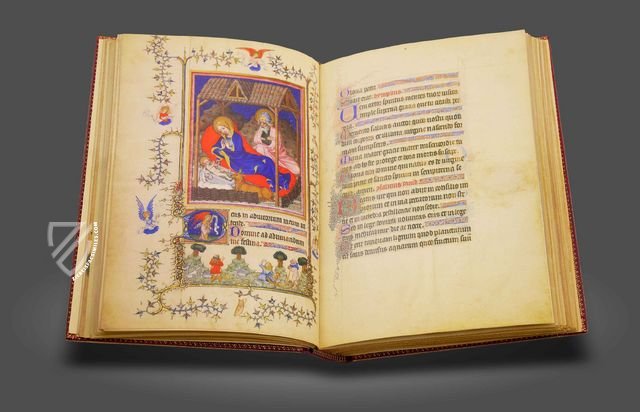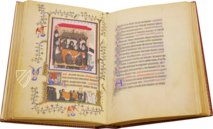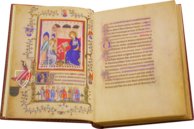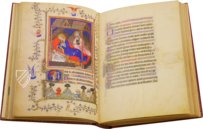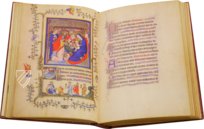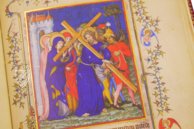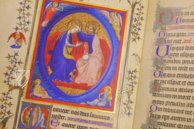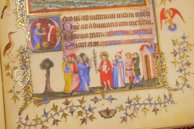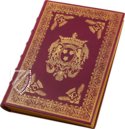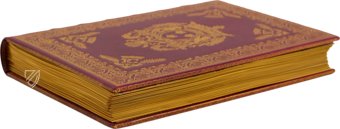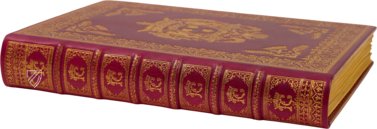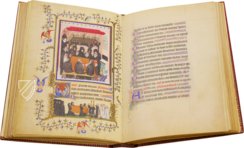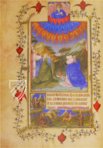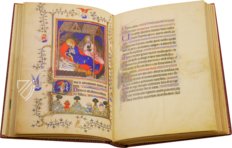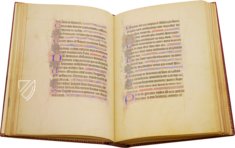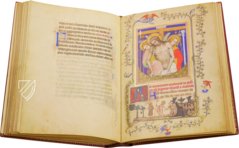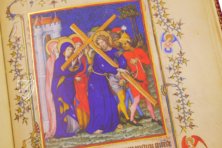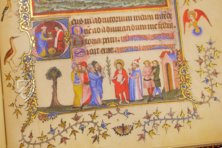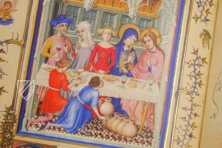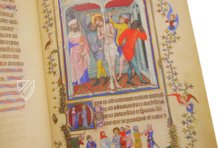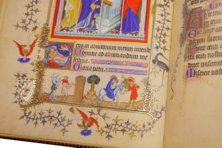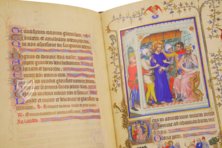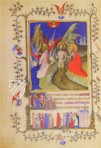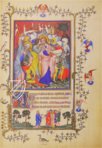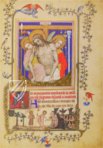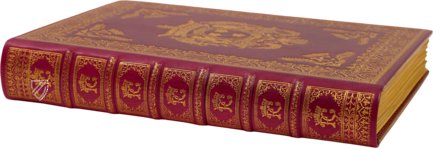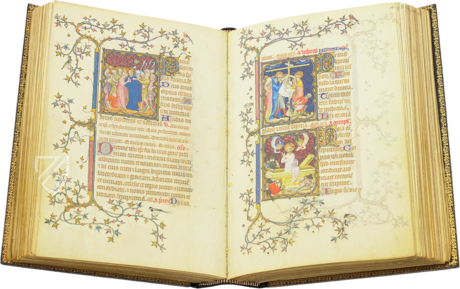Très Belles Heures de Notre-Dame
(1,000€ - 3,000€)
This precious manuscript, aptly described in French as a "very beautiful book of hours," shows numerous influences of Flemish art and was created by various masters in several phases sometime between 1380 and 1412. The main scenes from the New Testament are juxtaposed with elaborate bas-de-page miniatures on the 25 miniature pages. Each page is set in a filigree border of ivy leaf vines interspersed with depictions of angels and small animals such as birds and butterflies. The book was originally commissioned by the famous bibliophile Duke Jean of Berry (1340–1416), who gave it to his treasurer Robinet d'Estampes in 1412. The miniatures resembling panel paintings are small works of art and make the manuscript as a whole a true masterpiece. Therefore, it is not surprising that it has been divided and sold in individual fragments several times during its long history. However, the core of the book of hours has been preserved over the centuries and is presented here.
Les Très Belles Heures de Notre-Dame (Turin-Milan Hours)
The Très Belles Heures de Notre-Dame is a valuable and artfully adorned book of hours that resides in Paris. The book was commissioned by the Duke of Berry in 1380, intended to be part of his well-known collection. It is counted among the most magnificent prayer books of the Middle Ages, along with the lost Turin Prayer Book and Turin-Milan Hours. The artists – great names of their time – created large-format miniatures, composed the matching bas-de-page vignettes underneath, and decorated the pages with golden acanthus leaves. Thanks to their outstanding quality, these miniature pages are among the highlights of medieval illumination.
Constantly Changing Hands
The Très Belles Heures de Notre-Dame is connected with the Duke of Berry, one of the greatest patrons and collectors of art in history. The Duke gave the work, which he had commissioned, to his treasurer Robinet d'Estampes in 1412. It was he who decided to divide the manuscript into three parts, of which he retained the actual book of hours, while the other parts with the special prayers to individual saints and the missal were sold to the House of Bavaria-Holland. The latter part was subsequently divided as well, with the missal sent to Milan, and the prayer section sent to Turin (which was unfortunately heavily damaged in a fire in 1904). Today, this combination is known as the Turin-Milan Hours. In its original form, the unusually monumental work is an outstanding highpoint of medieval book art that continues to amaze in its constituent parts. The Très Belles Heures de Notre-Dame came into the possession of Baron Alphonse de Rothschild, whose family would eventually gifted the work to the French National Library in 1956.
One Manuscript, Many Masters
The book of hours, aptly named “very beautiful Book” in French, shines with 25 miniature pages, which depict a variety of masterful art. This is probably due to the fact that many different participating artists added their own special touch to the panel paintings. The first of which, known as the “Master of the Parament of Narbonne”, was often employed by the French court and today has been identified as Jean d’Orleans. He was also the one who laid down the basic "layout" of the miniature pages, each with a large framed main picture, an intricately embellished initial, and a bas-de-page miniature at the bottom of the page – all well thought out and original in design. Especially fine are the ivy vines, interrupted by depictions of angels and small animals like birds and butterflies, which ornamentally surround each miniature. The miniatures of this book of hours from the hand of the "Parament Master" offer art history a more than convincing substitute for the largely lost French panel painting of this era.
French Art with Flemish Influences
Other participating artists could be identified with the “Master of John the Baptist” and “Holy Ghost Master”, who are connected to the tradition of Flemish artists. For instance, the impressive depiction of Christ’s baptism and resurrecting of the dead are shown. Next to the remarkable main paintings, the bas-de-page-miniatures are certainly worth a thorough look. In general, the wealth of figures in the entire manuscript, with its detailed studies of garments and faces, probably has no equal in contemporary art. There are also many curious discoveries to be made by an interested viewer, e.g. a painter set a bearded head on a female body among a group of worshipers. The last miniature pages, which were finally added in 1412, derive from the famous workshop of the brothers Paul and Jan Limbourg. The possibility that even more masters could have contributed to the Les Très Belles Heures de Notre-Dame is cause for wonderment and surely makes this work a worthy piece of any collection for every enthusiast of medieval book art.
Codicology
- Alternative Titles
- Les Très Belles Heures de Nôtre-Dame
- Size / Format
- 252 pages / 28.0 × 20.0 cm
- Origin
- France
- Date
- Around 1380, around 1404–1409, and around 1412
- Epochs
- Style
- Genre
- Language
- Illustrations
- 25 miniature pages
- Patron
- Duke Jean of Berry (1340–1416)
- Artist / School
- Master of Parement of Narbonne (Jean d'Orleans?)
Master of the Holy Gost
Master of John the Baptist - Previous Owners
- Robinet D'Estampes
Baron Alphonse de Rothschild
Très Belles Heures de Notre-Dame
Deposition from the Cross
Covered in wounds from being beaten and crucified, Christ is shown being taken down from the cross, but angels are shown performing the task instead of Apostles, making this an unusual depiction. The three figures are surrounded by the Arma Christi or “Weapons of Christ”. Aside from the True Cross, the Instruments of the Passion include the Crown of Thorns, column and whips used for the Flagellation of Christ (right), as well as the nails, Holy Lance, and Holy Sponge (left).

Très Belles Heures de Notre-Dame
The Crucifixion
This miniature of Christianity’s most iconic image manages to condense the final events of the Passion into a single that is second to none in terms of artistry. In the bas de page miniature, we see the nails being driven into Christ’s feet as the two thieves are being brought up to Golgotha. In the historiated initial, we see the soldiers casting lots for his seamless robe.
The primary miniature is even more dense, e.g. the red background is actually a sea of angels, the sun and moon flank the cross representing the eclipse that occurred. The vinegar-soaked sponge is extended to Christ’s mouth moments before his death. The moment after his death is also depicted and the Virgin Mary collapses as blood and water pour from his pierced side.

#1 Les Très Belles Heures de Notre-Dame
Languages: French, German
(1,000€ - 3,000€)
- Treatises / Secular Books
- Apocalypses / Beatus
- Astronomy / Astrology
- Bestiaries
- Bibles / Gospels
- Chronicles / History / Law
- Geography / Maps
- Saints' Lives
- Islam / Oriental
- Judaism / Hebrew
- Single Leaf Collections
- Leonardo da Vinci
- Literature / Poetry
- Liturgical Manuscripts
- Medicine / Botany / Alchemy
- Music
- Mythology / Prophecies
- Psalters
- Other Religious Books
- Games / Hunting
- Private Devotion Books
- Other Genres
- Afghanistan
- Armenia
- Austria
- Belgium
- Belize
- Bosnia and Herzegovina
- China
- Colombia
- Costa Rica
- Croatia
- Cyprus
- Czech Republic
- Denmark
- Egypt
- El Salvador
- Ethiopia
- France
- Germany
- Greece
- Guatemala
- Honduras
- Hungary
- India
- Iran
- Iraq
- Israel
- Italy
- Japan
- Jordan
- Kazakhstan
- Kyrgyzstan
- Lebanon
- Liechtenstein
- Luxembourg
- Mexico
- Morocco
- Netherlands
- Palestine
- Panama
- Peru
- Poland
- Portugal
- Romania
- Russia
- Serbia
- Spain
- Sri Lanka
- Sweden
- Switzerland
- Syria
- Tajikistan
- Turkey
- Turkmenistan
- Ukraine
- United Kingdom
- United States
- Uzbekistan
- Vatican City
- A. Oosthoek, van Holkema & Warendorf
- Aboca Museum
- Ajuntament de Valencia
- Akademie Verlag
- Akademische Druck- u. Verlagsanstalt (ADEVA)
- Aldo Ausilio Editore - Bottega d’Erasmo
- Alecto Historical Editions
- Alkuin Verlag
- Almqvist & Wiksell
- Amilcare Pizzi
- Andreas & Andreas Verlagsbuchhandlung
- Archa 90
- Archiv Verlag
- Archivi Edizioni
- Arnold Verlag
- ARS
- Ars Magna
- ArtCodex
- AyN Ediciones
- Azimuth Editions
- Badenia Verlag
- Bärenreiter-Verlag
- Belser Verlag
- Belser Verlag / WK Wertkontor
- Benziger Verlag
- Bernardinum Wydawnictwo
- BiblioGemma
- Biblioteca Apostolica Vaticana (Vaticanstadt, Vaticanstadt)
- Bibliotheca Palatina Faksimile Verlag
- Bibliotheca Rara
- Boydell & Brewer
- Bramante Edizioni
- Bredius Genootschap
- Brepols Publishers
- British Library
- C. Weckesser
- Caixa Catalunya
- Canesi
- CAPSA, Ars Scriptoria
- Caratzas Brothers, Publishers
- Carus Verlag
- Casamassima Libri
- Centrum Cartographie Verlag GmbH
- Chavane Verlag
- Christian Brandstätter Verlag
- Circulo Cientifico
- Club Bibliófilo Versol
- Club du Livre
- CM Editores
- Collegium Graphicum
- Collezione Apocrifa Da Vinci
- Comissão Nacional para as Comemorações dos Descobrimentos Portugueses
- Coron Verlag
- Corvina
- CTHS
- D. S. Brewer
- Damon
- De Agostini/UTET
- De Nederlandsche Boekhandel
- De Schutter
- Deuschle & Stemmle
- Deutscher Verlag für Kunstwissenschaft
- DIAMM
- Droz
- E. Schreiber Graphische Kunstanstalten
- Ediciones Boreal
- Ediciones Grial
- Ediclube
- Edições Inapa
- Edilan
- Editalia
- Edition Deuschle
- Edition Georg Popp
- Edition Leipzig
- Edition Libri Illustri
- Editiones Reales Sitios S. L.
- Éditions de l'Oiseau Lyre
- Editions Medicina Rara
- Editorial Casariego
- Editorial Mintzoa
- Editrice Antenore
- Editrice Velar
- Edizioni Edison
- Egeria, S.L.
- Eikon Editores
- Electa
- Emery Walker Limited
- Enciclopèdia Catalana
- Eos-Verlag
- Ephesus Publishing
- Ernst Battenberg
- Eugrammia Press
- Extraordinary Editions
- Fackelverlag
- Facsimila Art & Edition
- Facsimile Editions Ltd.
- Facsimilia Art & Edition Ebert KG
- Faksimile Verlag
- Feuermann Verlag
- Folger Shakespeare Library
- Franco Cosimo Panini Editore
- Friedrich Wittig Verlag
- Fundación Hullera Vasco-Leonesa
- G. Braziller
- Gabriele Mazzotta Editore
- Gebr. Mann Verlag
- Gesellschaft für graphische Industrie
- Getty Research Institute
- Giovanni Domenico de Rossi
- Giunti Editore
- Graffiti
- Grafica European Center of Fine Arts
- Guido Pressler
- Guillermo Blazquez
- Gustav Kiepenheuer
- H. N. Abrams
- Harrassowitz
- Harvard University Press
- Helikon
- Hendrickson Publishers
- Henning Oppermann
- Herder Verlag
- Hes & De Graaf Publishers
- Hoepli
- Holbein-Verlag
- Houghton Library
- Hugo Schmidt Verlag
- Idion Verlag
- Il Bulino, edizioni d'arte
- ILte
- Imago
- Insel Verlag
- Insel-Verlag Anton Kippenberger
- Instituto de Estudios Altoaragoneses
- Instituto Nacional de Antropología e Historia
- Istituto dell'Enciclopedia Italiana - Treccani
- Istituto Ellenico di Studi Bizantini e Postbizantini
- Istituto Geografico De Agostini
- Istituto Poligrafico e Zecca dello Stato
- Italarte Art Establishments
- Jan Thorbecke Verlag
- Johnson Reprint Corporation
- Josef Stocker
- Josef Stocker-Schmid
- Jugoslavija
- Karl W. Hiersemann
- Kasper Straube
- Kaydeda Ediciones
- Kindler Verlag / Coron Verlag
- Kodansha International Ltd.
- Konrad Kölbl Verlag
- Kurt Wolff Verlag
- La Liberia dello Stato
- La Linea Editrice
- La Meta Editore
- Lambert Schneider
- Landeskreditbank Baden-Württemberg
- Leo S. Olschki
- Les Incunables
- Liber Artis
- Library of Congress
- Libreria Musicale Italiana
- Lichtdruck
- Lito Immagine Editore
- Lumen Artis
- Lund Humphries
- M. Moleiro Editor
- Maison des Sciences de l'homme et de la société de Poitiers
- Manuscriptum
- Martinus Nijhoff
- Maruzen-Yushodo Co. Ltd.
- MASA
- Massada Publishers
- McGraw-Hill
- Metropolitan Museum of Art
- Militos
- Millennium Liber
- Müller & Schindler
- Nahar - Stavit
- Nahar and Steimatzky
- National Library of Wales
- Neri Pozza
- Nova Charta
- Oceanum Verlag
- Odeon
- Orbis Mediaevalis
- Orbis Pictus
- Österreichische Staatsdruckerei
- Oxford University Press
- Pageant Books
- Parzellers Buchverlag
- Patrimonio Ediciones
- Pattloch Verlag
- PIAF
- Pieper Verlag
- Plon-Nourrit et cie
- Poligrafiche Bolis
- Presses Universitaires de Strasbourg
- Prestel Verlag
- Princeton University Press
- Prisma Verlag
- Priuli & Verlucca, editori
- Pro Sport Verlag
- Propyläen Verlag
- Pytheas Books
- Quaternio Verlag Luzern
- Reales Sitios
- Recht-Verlag
- Reichert Verlag
- Reichsdruckerei
- Reprint Verlag
- Riehn & Reusch
- Roberto Vattori Editore
- Rosenkilde and Bagger
- Roxburghe Club
- Salerno Editrice
- Saltellus Press
- Sandoz
- Sarajevo Svjetlost
- Schöck ArtPrint Kft.
- Schulsinger Brothers
- Scolar Press
- Scrinium
- Scripta Maneant
- Scriptorium
- Shazar
- Siloé, arte y bibliofilia
- SISMEL - Edizioni del Galluzzo
- Sociedad Mexicana de Antropología
- Société des Bibliophiles & Iconophiles de Belgique
- Soncin Publishing
- Sorli Ediciones
- Stainer and Bell
- Studer
- Styria Verlag
- Sumptibus Pragopress
- Szegedi Tudomànyegyetem
- Taberna Libraria
- Tarshish Books
- Taschen
- Tempus Libri
- Testimonio Compañía Editorial
- Thames and Hudson
- The Clear Vue Publishing Partnership Limited
- The Facsimile Codex
- The Folio Society
- The Marquess of Normanby
- The Richard III and Yorkist History Trust
- Tip.Le.Co
- TouchArt
- TREC Publishing House
- TRI Publishing Co.
- Trident Editore
- Tuliba Collection
- Typis Regiae Officinae Polygraphicae
- Union Verlag Berlin
- Universidad de Granada
- University of California Press
- University of Chicago Press
- Urs Graf
- Vallecchi
- Van Wijnen
- VCH, Acta Humaniora
- VDI Verlag
- VEB Deutscher Verlag für Musik
- Verlag Anton Pustet / Andreas Verlag
- Verlag Bibliophile Drucke Josef Stocker
- Verlag der Münchner Drucke
- Verlag für Regionalgeschichte
- Verlag Styria
- Vicent Garcia Editores
- W. Turnowski Ltd.
- W. Turnowsky
- Waanders Printers
- Wiener Mechitharisten-Congregation (Wien, Österreich)
- Wissenschaftliche Buchgesellschaft
- Wissenschaftliche Verlagsgesellschaft
- Wydawnictwo Dolnoslaskie
- Xuntanza Editorial
- Zakład Narodowy
- Zollikofer AG

